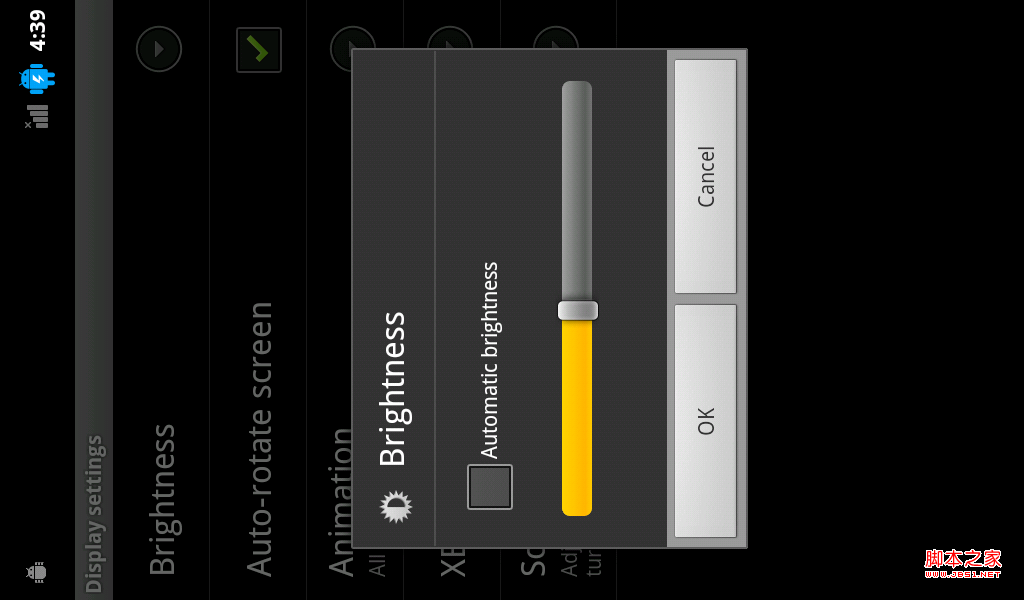編輯:Android開發實例
Activity
Android中,Activity是所有程序的根本,所有程序的流程都運行在Activity之中,Activity具有自己的生命周期(由系統控制生命周期,程序無法改變,但可以用onSaveInstanceState保存其狀態)。
對於Activity,關鍵是其生命周期的把握(如那張經典的生命周期圖=.=),其次就是狀態的保存和恢復(onSaveInstanceState onRestoreInstanceState),以及Activity之間的跳轉和數據傳輸(intent)。
Activity中常用的函數有SetContentView() findViewById() finish() startActivity(),其生命周期涉及的函數有:
void onCreate(Bundle savedInstanceState)
void onStart()
void onRestart()
void onResume()
void onPause()
void onStop()
void onDestroy()
注意的是,Activity的使用需要在Manifest文件中添加相應的<Activity>,並設置其屬性和intent-filter。
Intent
Android中提供了Intent機制來協助應用間的交互與通訊,Intent負責對應用中一次操作的動作、動作涉及數據、附加數據進行描述,Android則根據此Intent的描述,負責找到對應的組件,將 Intent傳遞給調用的組件,並完成組件的調用。Intent不僅可用於應用程序之間,也可用於應用程序內部的Activity/Service之間的交互。因此,Intent在這裡起著一個媒體中介的作用,專門提供組件互相調用的相關信息,實現調用者與被調用者之間的解耦。在SDK中給出了Intent作用的表現形式為:
· 通過Context.startActivity() orActivity.startActivityForResult() 啟動一個Activity;
· 通過 Context.startService() 啟動一個服務,或者通過Context.bindService() 和後台服務交互;
· 通過廣播方法(比如 Context.sendBroadcast(),Context.sendOrderedBroadcast(), Context.sendStickyBroadcast()) 發給broadcast receivers。
Intent屬性的設置,包括以下幾點:(以下為XML中定義,當然也可以通過Intent類的方法來獲取和設置)
(1)Action,也就是要執行的動作
SDk中定義了一些標准的動作,包括
onstant
Target component
Action
ACTION_CALL
activity
Initiate a phone call.
ACTION_EDIT
activity
Display data for the user to edit.
ACTION_MAIN
activity
Start up as the initial activity of a task, with no data input and no returned output.
ACTION_SYNC
activity
Synchronize data on a server with data on the mobile device.
ACTION_BATTERY_LOW
broadcast receiver
A warning that the battery is low.
ACTION_HEADSET_PLUG
broadcast receiver
A headset has been plugged into the device, or unplugged from it.
ACTION_SCREEN_ON
broadcast receiver
The screen has been turned on.
ACTION_TIMEZONE_CHANGED
broadcast receiver
The setting for the time zone has changed.
當然,也可以自定義動作(自定義的動作在使用時,需要加上包名作為前綴,如"com.example.project.SHOW_COLOR”),並可定義相應的Activity來處理我們的自定義動作。
(2)Data,也就是執行動作要操作的數據
Android中采用指向數據的一個URI來表示,如在聯系人應用中,一個指向某聯系人的URI可能為:content://contacts/1。對於不同的動作,其URI數據的類型是不同的(可以設置type屬性指定特定類型數據),如ACTION_EDIT指定Data為文件URI,打電話為tel:URI,訪問網絡為http:URI,而由content provider提供的數據則為content: URIs。
(3)type(數據類型),顯式指定Intent的數據類型(MIME)。一般Intent的數據類型能夠根據數據本身進行判定,但是通過設置這個屬性,可以強制采用顯式指定的類型而不再進行推導。
(4)category(類別),被執行動作的附加信息。例如 LAUNCHER_CATEGORY 表示Intent 的接受者應該在Launcher中作為頂級應用出現;而ALTERNATIVE_CATEGORY表示當前的Intent是一系列的可選動作中的一個,這些動作可以在同一塊數據上執行。還有其他的為
Constant
Meaning
CATEGORY_BROWSABLE
The target activity can be safely invoked by the browser to display data referenced by a link — for example, an image or an e-mail message.
CATEGORY_GADGET
The activity can be embedded inside of another activity that hosts gadgets.
CATEGORY_HOME
The activity displays the home screen, the first screen the user sees when the device is turned on or when the HOME key is pressed.
CATEGORY_LAUNCHER
The activity can be the initial activity of a task and is listed in the top-level application launcher.
CATEGORY_PREFERENCE
The target activity is a preference panel.
(5)component(組件),指定Intent的的目標組件的類名稱。通常 Android會根據Intent 中包含的其它屬性的信息,比如action、data/type、category進行查找,最終找到一個與之匹配的目標組件。但是,如果 component這個屬性有指定的話,將直接使用它指定的組件,而不再執行上述查找過程。指定了這個屬性以後,Intent的其它所有屬性都是可選的。
(6)extras(附加信息),是其它所有附加信息的集合。使用extras可以為組件提供擴展信息,比如,如果要執行“發送電子郵件”這個動作,可以將電子郵件的標題、正文等保存在extras裡,傳給電子郵件發送組件。
理解Intent的關鍵之一是理解清楚Intent的兩種基本用法:一種是顯式的Intent,即在構造Intent對象時就指定接收者;另一種是隱式的Intent,即Intent的發送者在構造Intent對象時,並不知道也不關心接收者是誰,有利於降低發送者和接收者之間的耦合。
對於顯式Intent,Android不需要去做解析,因為目標組件已經很明確,Android需要解析的是那些隱式Intent,通過解析,將 Intent映射給可以處理此Intent的Activity、IntentReceiver或Service。
Intent解析機制主要是通過查找已注冊在AndroidManifest.xml中的所有IntentFilter及其中定義的Intent,最終找到匹配的Intent。在這個解析過程中,Android是通過Intent的action、type、category這三個屬性來進行判斷的,判斷方法如下:
· 如果Intent指明定了action,則目標組件的IntentFilter的action列表中就必須包含有這個action,否則不能匹配;
· 如果Intent沒有提供type,系統將從data中得到數據類型。和action一樣,目標組件的數據類型列表中必須包含Intent的數據類型,否則不能匹配。
· 如果Intent中的數據不是content: 類型的URI,而且Intent也沒有明確指定它的type,將根據Intent中數據的scheme (比如 http: 或者mailto:) 進行匹配。同上,Intent 的scheme必須出現在目標組件的scheme列表中。
· 如果Intent指定了一個或多個category,這些類別必須全部出現在組建的類別列表中。比如Intent中包含了兩個類別:LAUNCHER_CATEGORY 和 ALTERNATIVE_CATEGORY,解析得到的目標組件必須至少包含這兩個類別。
Intent-Filter的定義
一些屬性設置的例子:
<action android:name="com.example.project.SHOW_CURRENT" />
<category android:name="android.intent.category.DEFAULT" />
<data android:mimeType="video/mpeg" android:scheme="http" . . . />
<data android:mimeType="image/*" />
<data android:scheme="http" android:type="video/*" />
完整的實例
<activity android:name="NotesList" android:label="@string/title_notes_list">
<intent-filter>
<action android:name="android.intent.action.MAIN"/>
<category android:name="android.intent.category.LAUNCHER"/>
</intent-filter>
<intent-filter>
<action android:name="android.intent.action.VIEW"/>
<action android:name="android.intent.action.EDIT"/>
<action android:name="android.intent.action.PICK"/>
<category android:name="android.intent.category.DEFAULT"/>
<data android:mimeType="vnd.android.cursor.dir/vnd.google.note"/>
</intent-filter>
<intent-filter>
<action android:name="android.intent.action.GET_CONTENT"/>
<category android:name="android.intent.category.DEFAULT"/>
<data android:mimeType="vnd.android.cursor.item/vnd.google.note"/>
</intent-filter>
</activity>
Intent用法實例
1.無參數Activity跳轉
Intent it = new Intent(Activity.Main.this, Activity2.class);
startActivity(it);
2.向下一個Activity傳遞數據(使用Bundle和Intent.putExtras)
Intent it = new Intent(Activity.Main.this, Activity2.class);
Bundle bundle=new Bundle();
bundle.putString("name", "This is from MainActivity!");
it.putExtras(bundle); // it.putExtra(“test”, "shuju”);
startActivity(it); // startActivityForResult(it,REQUEST_CODE);
對於數據的獲取可以采用:
Bundle bundle=getIntent().getExtras();String name=bundle.getString("name");
3.向上一個Activity返回結果(使用setResult,針對startActivityForResult(it,REQUEST_CODE)啟動的Activity)
Intent intent=getIntent();
Bundle bundle2=new Bundle();
bundle2.putString("name", "This is from ShowMsg!");
intent.putExtras(bundle2);
setResult(RESULT_OK, intent);
4.回調上一個Activity的結果處理函數(onActivityResult)
@Override protected void onActivityResult(int requestCode, int resultCode, Intent data) {
// TODO Auto-generated method stub
super.onActivityResult(requestCode, resultCode, data);
if (requestCode==REQUEST_CODE){
if(resultCode==RESULT_CANCELED)
setTitle("cancle");
else if (resultCode==RESULT_OK) {
String temp=null;
Bundle bundle=data.getExtras();
if(bundle!=null) temp=bundle.getString("name");
setTitle(temp);
}
}
}
下面是轉載來的其他的一些Intent用法實例(轉自javaeye)
顯示網頁
1. Uri uri = Uri.parse("http://google.com");
2. Intent it = new Intent(Intent.ACTION_VIEW, uri);
3. startActivity(it);
顯示地圖
1. Uri uri = Uri.parse("geo:38.899533,-77.036476");
2. Intent it = new Intent(Intent.ACTION_VIEW, uri);
3. startActivity(it);
4. //其他 geo URI 範例
5. //geo:latitude,longitude
6. //geo:latitude,longitude?z=zoom
7. //geo:0,0?q=my+street+address
8. //geo:0,0?q=business+near+city
9. //google.streetview:cbll=lat,lng&cbp=1,yaw,,pitch,zoom&mz=mapZoom
路徑規劃
1. Uri uri = Uri.parse("http://maps.google.com/maps?f=d&saddr=startLat%20startLng&daddr=endLat%20endLng&hl=en");
2. Intent it = new Intent(Intent.ACTION_VIEW, uri);
3. startActivity(it);
4. //where startLat, startLng, endLat, endLng are a long with 6 decimals like: 50.123456
打電話
1. //叫出撥號程序
2. Uri uri = Uri.parse("tel:0800000123");
3. Intent it = new Intent(Intent.ACTION_DIAL, uri);
4. startActivity(it);
1. //直接打電話出去
2. Uri uri = Uri.parse("tel:0800000123");
3. Intent it = new Intent(Intent.ACTION_CALL, uri);
4. startActivity(it);
5. //用這個,要在 AndroidManifest.xml 中,加上
6. //<uses-permission id="android.permission.CALL_PHONE" />
傳送SMS/MMS
1. //調用短信程序
2. Intent it = new Intent(Intent.ACTION_VIEW, uri);
3. it.putExtra("sms_body", "The SMS text");
4. it.setType("vnd.android-dir/mms-sms");
5. startActivity(it);
1. //傳送消息
2. Uri uri = Uri.parse("smsto://0800000123");
3. Intent it = new Intent(Intent.ACTION_SENDTO, uri);
4. it.putExtra("sms_body", "The SMS text");
5. startActivity(it);
1. //傳送 MMS
2. Uri uri = Uri.parse("content://media/external/images/media/23");
3. Intent it = new Intent(Intent.ACTION_SEND);
4. it.putExtra("sms_body", "some text");
5. it.putExtra(Intent.EXTRA_STREAM, uri);
6. it.setType("image/png");
7. startActivity(it);
傳送 Email
1. Uri uri = Uri.parse("mailto:[email protected]");
2. Intent it = new Intent(Intent.ACTION_SENDTO, uri);
3. startActivity(it);
1. Intent it = new Intent(Intent.ACTION_SEND);
2. it.putExtra(Intent.EXTRA_EMAIL, "[email protected]");
3. it.putExtra(Intent.EXTRA_TEXT, "The email body text");
4. it.setType("text/plain");
5. startActivity(Intent.createChooser(it, "Choose Email Client"));
1. Intent it=new Intent(Intent.ACTION_SEND);
2. String[] tos={"[email protected]"};
3. String[] ccs={"[email protected]"};
4. it.putExtra(Intent.EXTRA_EMAIL, tos);
5. it.putExtra(Intent.EXTRA_CC, ccs);
6. it.putExtra(Intent.EXTRA_TEXT, "The email body text");
7. it.putExtra(Intent.EXTRA_SUBJECT, "The email subject text");
8. it.setType("message/rfc822");
9. startActivity(Intent.createChooser(it, "Choose Email Client"));
1. //傳送附件
2. Intent it = new Intent(Intent.ACTION_SEND);
3. it.putExtra(Intent.EXTRA_SUBJECT, "The email subject text");
4. it.putExtra(Intent.EXTRA_STREAM, "file:///sdcard/mysong.mp3");
5. sendIntent.setType("audio/mp3");
6. startActivity(Intent.createChooser(it, "Choose Email Client"));
播放多媒體
Uri uri = Uri.parse("file:///sdcard/song.mp3");
Intent it = new Intent(Intent.ACTION_VIEW, uri);
it.setType("audio/mp3");
startActivity(it);
Uri uri = Uri.withAppendedPath(MediaStore.Audio.Media.INTERNAL_CONTENT_URI, "1");
Intent it = new Intent(Intent.ACTION_VIEW, uri);
startActivity(it);
Market 相關
1. //尋找某個應用
2. Uri uri = Uri.parse("market://search?q=pname:pkg_name");
3. Intent it = new Intent(Intent.ACTION_VIEW, uri);
4. startActivity(it);
5. //where pkg_name is the full package path for an application
1. //顯示某個應用的相關信息
2. Uri uri = Uri.parse("market://details?id=app_id");
3. Intent it = new Intent(Intent.ACTION_VIEW, uri);
4. startActivity(it);
5. //where app_id is the application ID, find the ID
6. //by clicking on your application on Market home
7. //page, and notice the ID from the address bar
Uninstall 應用程序
1. Uri uri = Uri.fromParts("package", strPackageName, null);
2. Intent it = new Intent(Intent.ACTION_DELETE, uri);
3. startActivity(it);
service
service是沒有界面的長生命周期的代碼。一個很好的例子是媒體播放器從列表中播放歌曲。在一個媒體播放器程序中,大概要有一個或多個活動(activity)來供用戶選擇歌曲並播放它。然而,音樂的回放就不能使用活動(activity)了,因為用戶希望他導航到其他界面時音樂繼續播放。這種情況下,媒體播放器活動(activity)要用Context.startService()啟動一個服務來在後台運行保持音樂的播放。系統將保持這個音樂回放服務的運行直到它結束。注意一下,你要用Context.bindService()方法連接服務(如果它沒有運行,要先啟動它)。當連接到服務後,你可以通過服務暴露的一個接口和它通信。對於音樂服務,它允許你暫停、倒帶,等等。
Broadcast和BroadcaseReceiver
Android BroadcastReceiver 簡介
在 Android 中使用 Activity, Service, Broadcast, BroadcastReceiver
活動(Activity) - 用於表現功能
服務(Service) - 相當於後台運行的 Activity
廣播(Broadcast) - 用於發送廣播
廣播接收器(BroadcastReceiver) - 用於接收廣播
Intent - 用於連接以上各個組件,並在其間傳遞消息
BroadcastReceiver
在Android中,Broadcast是一種廣泛運用的在應用程序之間傳輸信息的機制。而BroadcastReceiver是對發送出來的 Broadcast進行過濾接受並響應的一類組件。下面將詳細的闡述如何發送Broadcast和使用BroadcastReceiver過
濾接收的過程:
首先在需要發送信息的地方,把要發送的信息和用於過濾的信息(如Action、Category)裝入一個Intent對象,然後通過調用 Context.sendBroadcast()、sendOrderBroadcast()或sendStickyBroadcast()方法,把 Intent對象以廣播方式發送出去。
當Intent發送以後,所有已經注冊的BroadcastReceiver會檢查注冊時的IntentFilter是否與發送的Intent相匹配,若 匹配則就會調用BroadcastReceiver的onReceive()方法。所以當我們定義一個BroadcastReceiver的時候,都需要 實現onReceive()方法。
注冊BroadcastReceiver有兩種方式:
一種方式是,靜態的在AndroidManifest.xml中用<receiver>標簽生命注冊,並在標簽內用<intent- filter>標簽設置過濾器。
另一種方式是,動態的在代碼中先定義並設置好一個 IntentFilter對象,然後在需要注冊的地方調 Context.registerReceiver()方法,如果取消時就調用Context.unregisterReceiver()方法。
不管是用xml注冊的還是用代碼注冊的,在程序退出的時候沒有特殊需要都得注銷,否則下次啟動程序可能會有多個 BroadcastReceiver
另外,若在使用sendBroadcast()的方法是指定了接收權限,則只有在AndroidManifest.xml中用<uses- permission>標簽聲明了擁有此權限的BroascastReceiver才會有可能接收到發送來的Broadcast。
同樣,若在注冊BroadcastReceiver時指定了可接收的Broadcast的權限,則只有在包內的AndroidManifest.xml中 用<uses-permission>標簽聲明了,擁有此權限的Context對象所發送的Broadcast才能被這個 BroadcastReceiver所接收。
動態注冊:
IntentFilter intentFilter = new IntentFilter();
intentFilter.addAction(String);--為 BroadcastReceiver指定action,使之用於接收同action的廣播 registerReceiver(BroadcastReceiver,intentFilter);
一般:在onStart中注冊,onStop中取消unregisterReceiver
發送廣播消息:extends Service
指定廣播目標Action:Intent Intent = new Intent(action-String)
--指定了此action的receiver會接收此廣播
需傳遞參數(可選) putExtra();
發送:sendBroadcast(Intent);
 Android本地化
Android本地化
Android應用程序可以在許多不同地區的許多設備上運行。為了使應用程序更具交互性,應用程序應該處理以適合應用程序將要使用的語言環境方面的文字,數字,文件等。在本章中,我
 通過OpenGL ES混合模式縮放視頻緩沖區來適應顯示尺寸
通過OpenGL ES混合模式縮放視頻緩沖區來適應顯示尺寸
當開發基於軟件模式的游戲時,通過縮放視頻緩沖區來適應顯示尺寸是最棘手的問題之一。當面對眾多不同的分辨率時(比如開放環境下的Android),該問題會變得更加麻煩,
 Android MediaPlayer(多媒體播放)
Android MediaPlayer(多媒體播放)
Android提供了許多方法來控制播放的音頻/視頻文件和流。其中該方法是通過一類稱為MediaPlayer。Android是提供MediaPlayer類訪問內置的媒體播放
 android 屏幕亮度調節方法詳解
android 屏幕亮度調節方法詳解
屏幕亮度自動調節:主要是從Sensor分析之中分離出來分析LIGHT 光線感應器,因此就分析一下自動調節屏幕亮度(手機隨著光線的強度自我調節,也就是在亮的光線下屏